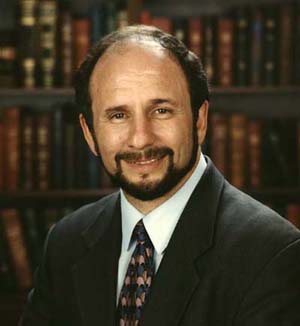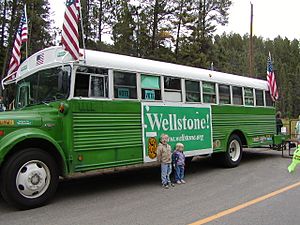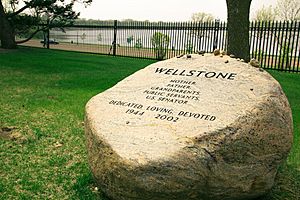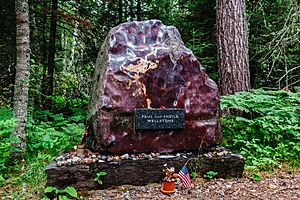Paul Wellstone facts for kids
Quick facts for kids
Paul Wellstone
|
|
|---|---|
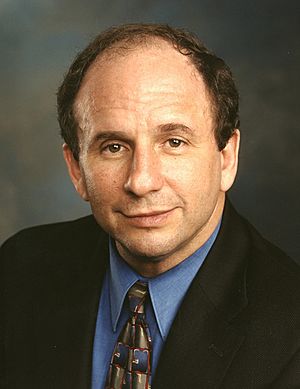 |
|
| United States Senator from Minnesota |
|
| In office January 3, 1991 – October 25, 2002 |
|
| Preceded by | Rudy Boschwitz |
| Succeeded by | Dean Barkley |
| Personal details | |
| Born |
Paul David Wellstone
July 21, 1944 Washington, D.C., U.S. |
| Died | October 25, 2002 (aged 58) Eveleth, Minnesota, U.S. |
| Political party | Democratic |
| Spouse |
Sheila Ison
(m. 1963) |
| Children | 3 |
| Education | University of North Carolina, Chapel Hill (BA, MA, PhD) |
Paul David Wellstone (born July 21, 1944 – died October 25, 2002) was an American teacher, writer, and politician. He represented the state of Minnesota in the United States Senate from 1991 until he passed away in a plane crash in 2002. As a member of the Democratic Party, Wellstone was known for supporting ordinary people and working for social improvements.
Paul grew up in Northern Virginia and later went to the University of North Carolina at Chapel Hill. There, he earned his bachelor's degree and a doctorate in political science. In 1969, Wellstone became a professor at Carleton College in Northfield, Minnesota. He taught there until he was elected to the Senate in 1990. He also worked as a local activist, helping people in rural Rice County.
In 1990, Wellstone ran for the U.S. Senate against Rudy Boschwitz. Many thought Wellstone would lose because Boschwitz spent much more money on his campaign. But Wellstone used a "grassroots" approach, meaning he got support from many ordinary people. He became famous for traveling in his green school bus. He won the election, which was a big surprise. He was the only person that year to defeat a sitting senator. He won again in 1996, beating Boschwitz a second time.
As a U.S. Senator, Wellstone worked to protect the environment, support workers' rights, and improve health care. He also helped create a law called the "Wellstone Amendment" for campaign finance reform. This law aimed to make political campaigns fairer. Sadly, Paul Wellstone died in a plane crash in 2002, just weeks before another election. His wife, Sheila, and daughter, Marcia, also died in the crash. After his death, former Vice President Walter Mondale took his place on the ballot but lost the election. Wellstone's sons, David and Mark, later helped run an organization called Wellstone Action (now Re:Power) to honor their parents.
Contents
Early Life and Learning
Paul Wellstone was born in Washington, D.C.. He was the second son of immigrants from Ukraine. His father changed the family name from Wexelstein because of unfair treatment they faced. Paul grew up in Arlington, Virginia, and went to public schools there. He graduated from Yorktown High School in 1962.
Wellstone attended the University of North Carolina at Chapel Hill (UNC) with a scholarship for wrestling. He was a very good wrestler in college. After his first year, he married Sheila Ison Wellstone. He earned his bachelor's degree in political science in 1965. In 1969, Wellstone received his PhD in political science from UNC. His studies focused on how people in communities fought for their rights.
Helping Communities and Early Activism
In 1969, Wellstone started teaching political science at Carleton College in Northfield, Minnesota. He taught there until he was elected to the Senate in 1990. In the 1970s and 1980s, he also began helping communities organize. He worked with people who were struggling financially and those who felt left out of politics. He started a group called the Organization for a Better Rice County. This group helped single parents and advocated for things like affordable housing, health care, and better schools. In 1978, he wrote a book about his work called How the Rural Poor Got Power.
Wellstone was arrested a couple of times for peaceful protests. In 1970, he was arrested for protesting the Vietnam War. In 1984, he was arrested again for protesting against a bank that was taking people's homes.
He also supported the labor movement in Minnesota. In 1985, he joined workers on the picket line during a strike at the Hormel Meat Packing plant. The Minnesota National Guard was called in during this strike.
At one point, the leaders at Carleton College briefly fired Wellstone because of his activism. But his students held a sit-in (a peaceful protest), and the college rehired him. He became the youngest professor to get a permanent teaching position at Carleton.
First Steps in Politics
Wellstone first ran for public office in 1982. He became the Democratic candidate for Minnesota State Auditor. He gave a powerful speech at the state convention. In the election, he lost to the Republican candidate, Arne Carlson.
Wellstone stayed active in Democratic politics. He helped with Jesse Jackson's presidential campaign in Minnesota in 1988. After that, he also helped with Michael Dukakis's campaign in the state.
Running for the U.S. Senate
In 1990, Wellstone decided to run for the U.S. Senate against the sitting Senator Rudy Boschwitz. Wellstone was seen as a big underdog. He won the election even though Boschwitz spent seven times more money than he did. Wellstone used funny and unique ads that highlighted his underdog status.
Boschwitz also faced criticism for a letter his supporters sent to Jewish voters. The letter criticized Wellstone for marrying someone who wasn't Jewish and for not raising his children in the Jewish faith. Wellstone, who was also Jewish, responded on TV by saying, "He has a problem with Christians, then." This event likely hurt Boschwitz's campaign. Boschwitz was the only sitting U.S. senator to lose his election that year.
Wellstone beat Boschwitz again in 1996. During that campaign, Boschwitz ran ads calling Wellstone "embarrassingly liberal." He also accused Wellstone of supporting flag burning, which some believe backfired. Wellstone won by a good margin, even though he was again outspent.
Wellstone's wins in 1990 and 1996 were largely due to his grassroots campaigns. These campaigns encouraged college students, people with lower incomes, and minority groups to get involved in politics, many for the first time. In 1990, so many young people helped his campaign that Walter Mondale told Wellstone, "the kids won it for you." Wellstone also worked closely with the Hmong community in Minnesota and with veterans. He helped veterans get better health care and compensation.
In 2002, Wellstone ran for a third term, even though he had once promised to serve only two terms. His opponent was Norm Coleman, the mayor of St. Paul. Earlier that year, Wellstone announced he had a mild form of multiple sclerosis, which explained a limp he had.
What Paul Wellstone Believed In
Wellstone was known for his work on peace, protecting the environment, supporting workers, and improving health care. He and his wife, Sheila, also strongly supported the rights of victims of domestic violence. He made mental illness a key issue in his career. He also supported immigration to the U.S.
He was against the first Gulf War in 1991. In the months before he died, he spoke out against going to war with Iraq again. Groups like Americans for Democratic Action and the Sierra Club strongly supported him.
In 1996, he voted for the Defense of Marriage Act. However, he later said he made a mistake and learned more about the issue.
Wellstone was one of only eight senators to vote against getting rid of the Glass-Steagall Act in 1999. This act had separated banking activities.
After voting against the war in Iraq on October 11, 2002, Wellstone reportedly told his wife, "I just cost myself the election."
Wellstone also created the "Wellstone Amendment" for a law called the Bipartisan Campaign Reform Act of 2002. This amendment aimed to limit how much money special interest groups could spend on political ads. In 2010, the U.S. Supreme Court later removed some of these restrictions.
Thinking About Running for President
After winning reelection to the Senate in 1996, Wellstone thought about running for President in 2000. In 1997, he went on a "Children's Tour" across the country. He visited poor areas and big cities to highlight the challenges faced by children and families. He wanted to show that while some things had improved, many poor people still struggled.
In 1998, Wellstone set up a committee to explore a presidential run. He traveled to states important for early elections, like Iowa and New Hampshire. He used the slogan "I represent the democratic wing of the Democratic Party."
On January 9, 1999, Wellstone announced that he would not run for president. He said he didn't have enough energy for a national campaign because of chronic back problems. His pain was later found to be multiple sclerosis. He then supported Bill Bradley, another Democratic candidate.
Votes on Military Actions
Wellstone voted against allowing the use of force before the Persian Gulf War in 1991. He also voted against the use of force before the Iraq War in 2002. He was one of only 11 senators to vote against both of these actions.
However, Wellstone did support military actions requested by President Bill Clinton. These included operations in Somalia (1992), Haiti (1994), Bosnia and Herzegovina (1995), and Yugoslavia (1999).
His Passing
On October 25, 2002, Paul Wellstone, along with seven other people, died in a plane crash in northeastern Minnesota. He was 58 years old. His wife, Sheila; one of his three children, Marcia; the two pilots; and three campaign staff members also died. The plane was flying to Eveleth, where Wellstone was going to attend a funeral. He had a debate scheduled that night.
The plane crashed into a dense forest about two miles from the Eveleth airport. The National Transportation Safety Board (NTSB) investigated the crash. They looked into many factors, including weather conditions. The FBI also investigated for any foul play, as Wellstone had received threats before. However, they determined the crash was an accident.
The NTSB concluded that the most likely cause of the accident was that the pilots did not keep enough speed, which caused the plane to stall and fall. Other pilots had reported concerns about the flying skills of both the main pilot and the co-pilot.
What Happened Next
Paul Wellstone's death shocked many people, especially those who supported his ideas. He died just 11 days before his election. Minnesota law required that his name be removed from the ballot. The Democratic-Farmer-Labor Party chose former Vice President Walter Mondale to run in his place.
A memorial service for Wellstone and the other victims was held at the University of Minnesota. Many important politicians attended, including former President Bill Clinton. Some people criticized the service for being too political.
Minnesota Governor Jesse Ventura was upset by the tone of the memorial. He later appointed Dean Barkley to serve the remaining two months of Wellstone's term. In the election, Norm Coleman won Wellstone's Senate seat, defeating Walter Mondale.
His Lasting Impact
The AFL–CIO, a large group of labor unions, created the AFL–CIO Senator Paul Wellstone Award to honor people who support workers' rights. In 2004, the University of North Carolina at Chapel Hill dedicated the Paul and Sheila Wellstone Memorial Garden to honor the couple.
Near the site of the plane crash, a memorial to the Wellstones was opened in 2005. It includes his famous green bus and tells the story of his life and work. The memorial is a place for people to remember Paul, his family, and his staff.
Paul and Sheila Wellstone are buried at Lakewood Cemetery in Minneapolis. A sculpture marks their graves. Visitors sometimes place small stones on their grave markers, following a Jewish custom. Wellstone Action, a non-profit organization, continues to train people and potential political candidates who support progressive ideas.
In 2007, former First Lady Rosalynn Carter joined Paul's son, David Wellstone, to push for a law about mental health insurance. They worked to pass the Paul Wellstone and Pete Domenici Mental Health Parity and Addiction Equity Act of 2008. This law requires that mental health care be covered equally to physical health care by insurance policies. Paul Wellstone had a brother with mental illness, which made him passionate about this issue. The Emily Program, an eating disorder clinic, has a "Wellstone Room" dedicated to Paul and Sheila for their work on treating eating disorders.
In 2008, the House of Representatives passed the Paul Wellstone Mental Health and Addiction Equity Act of 2007. This law was a big step forward in ensuring fair mental health coverage.
Images for kids
See also
 In Spanish: Paul Wellstone para niños
In Spanish: Paul Wellstone para niños


